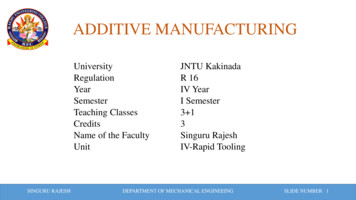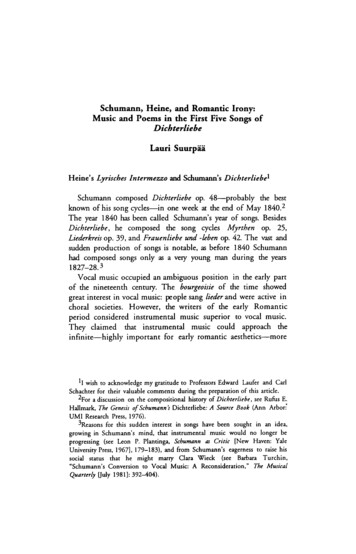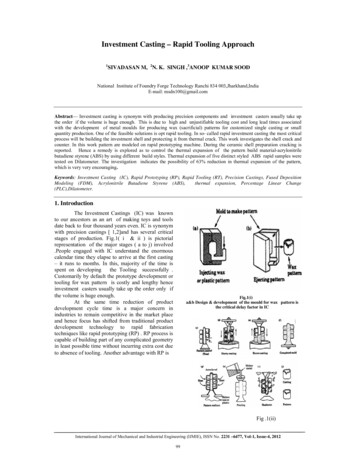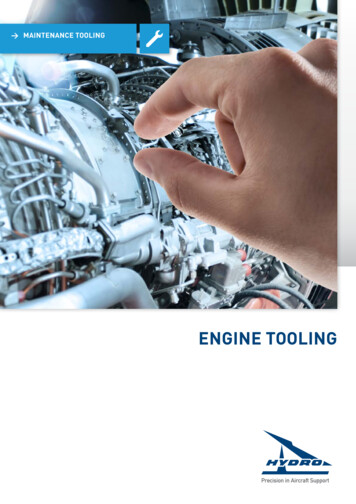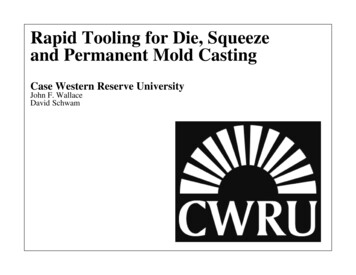
Transcription
Rapid Tooling for Die, Squeezeand Permanent Mold CastingCase Western Reserve UniversityJohn F. WallaceDavid Schwam
Rapid Tooling for Metal Mold ProcessesObjectives:Develop rapid, cost effective methods forfabricating metal tooling for the diecast,squeeze-cast, and permanent mold processes.Make the advantages of metal mold processesmore available to DLA’s short leadtime andlow volume casting needs.Approach:Evaluate and optimize die/mold materialselection and fabrication method for prototypequantities of castings (500-50,000).StatusTwo rapid metal tooling methods are currentlybeing evaluated: A ductile iron permanent mold cast at SaintLouis Precision Casting is used in productionat Arrow Aluminum; the thermal fatigueresistance of this mold is being monitored. Two die casting rapid inserts have beenmachined of P20 at CAM Tool and are inproduction of military components at SciCast.DeliverablesOn-line database of guidelines for selection ofmaterials and fabrication methods for rapidmetal tooling that will promote: Shorter lead times; Lower cost Tighter tolerances More metal molded castingsfor DLA low volume, high specification castingprocurements
What is Rapid Tooling For Metal MoldProcesses ?Quick and cost-effective methods of fabricating permanent mold,die/squeeze casting inserts, and/or metal slides and coresINWE DEAL WITHPROTOTYPINGMaking a small numberof castings (singles or tens)RAPID TOOLINGMaking one tool (mold, inserts,slides, cores) used to cast short tomedium production numbersof parts (hundreds to thousands)in a short period of time
Why Rapid Metal Mold Tooling? Current prototyping for short runs relies mostly on sand castcomponents. The performance and dimensional accuracy of metalmold castings provides an important option. The faster cooling rated attainable by permanent mold, die castingand squeeze casting provides higher integrity and bettermechanical properties. Commercial example: Safety critical control arms and steering knuckles onautomotive front suspensions made as aluminum squeeze castings Military example: Diecast chassis for an electronic system. More dimensionalaccuracy than sand casting, lower part cost than investment casting Military example: Diecast fuse for a munitions system. More dimensional accuracyand lower cost than a fabrication The key is quicker, lower cost tooling
DLA Need For Metal Mold Processes Short notice replacement of worn out parts in weapon systemswhen no “spares”are available. Often, the old part was investment cast and a metal mold process is a cost-effective option. New parts for systems under development for which metal moldprocesses would provide cost or functional advantages Will provide suppliers to DLA and weapon system OEM’s optionswhich complement sand, plaster, ceramic, and invest-ment castingprocesses commonly used in military applicationsAGM-88 HARM
Rapid Tooling ApproachThe focal point of this study is the MATERIAL and theFABRICATION METHOD of the rapid tooling:COSTCast H13Wrought4140Wrought P20Ductile IronGray IronTIGHT TOLERANCEWrought H13FABRICATION METHODDIE/MOLD LIFEMATERIALSNC MachiningInvestment CastingShaw ProcessSand Casting
Justification For DLAOptimized selection of die/mold materials and fabricationmethods will ensure the required number of productioncastings can be made, while targeting a 30% reduction intooling cost.About 7% of the US die casting 6 Billions is for the military,or 420 Million. Tooling cost can reach 20% or 84Million/year. An estimated 20% of these or 17 Million arefor short runs. At 25%-30% cost savings this translates intoabout 5 Million/year savings. The short term anticipated ROIis 15:1.The benefits of the project extend into all the branches of themilitary and the US casting industry.
Rapid Tooling Industry PartnersThe study involved industrial partners early on. Performance of rapidtooling fabricated during the study is monitored in production andcompared to the results of the simulated testing.FABRICATIONMETHODTOOL MAKERFOUNDRYNo-bake sandSt.Louis PrecisionArrow AluminumMachiningCAM Tool & Eng.SciCastInvestment castingPrecision MetalsmithTBDMetal SprayingRSP ToolingTBD
Rapid Tooling Materials Evaluation A key issue in selecting the material for rapid tooling is toensure it will last long enough to make the required number ofparts yet last no longer than necessary The Thermal Fatigue Immersion test at CWRU can simulatethe die casting or permanent mold casting environment, and isused to rate candidate materials for prototype dies and molds. This unique test has become the industry standard forevaluation of permanent mold and die materials. The mechanical properties of identical castings made withdifferent rapid tools will be compared.
Thermal Fatigue Immersion Test and Equipment(Intermittent immersion and cooling every 36 seconds)
Typical Thermal Fatigue Cycle For The Evaluation ofPermanent Mold Materials1000Temperature (F)900Diecasting tool materials are testedfor 15,000 cycles in the CWRU Lab80070060050040030020010001 3 5 7 9 11 13 15 17 19 21 23 25 27 29 31 33 35 37 39 41 43 45 47 49Time (sec.))
Thermal Fatigue Performance of Selected Mold MaterialsRepresents Resistance of Tools To Cracking350CWRU Ductile Iron/245BHN62Total Crack Area (x 10 µ m )300250CWRU Gray Iron-2 /228BHNCast 4140/Rc43Cast H13/Rc46Wrought H13/Rc47GI200DI outperformed GI150100For short runs DI equal to H1350DI (Ductile Iron)050010001500200025003000Thermal Cycles3500400045005000
DOD ComponentABRAMS M1A1 TankPART: Steering handleSUPPLIER: Arrow AluminumMETAL: A356PROCESS: Permanent MoldANNUAL USE: 500 unitsPROBLEM ADDRESSED: Long lead time to production of prototypes.SOLUTION: Metal mold was created as a casting using rapid prototyping technology
PART: Pole BaseSUPPLIER: Arrow AluminumMETAL: A356ANNUAL USE: 5,000 unitsThe sharp geometry changesmake this part a good test.PROBLEM ADDRESSED: Excessive thermal fatigue crackingof the permanent mold near the heavysections of the casting.SOLUTION: Metal mold made from cast ductile iron using a rapidprototyping technique. Ductile iron chosen as the tool material basedon thermal fatigue data from the the CWRU immersion tests. So far5,000 castings have been made with no tool cracking.
Ductile Iron Permanent Mold Inserts Cast at St. Louis Precision Castingwere delivered to Arrow AluminumPart geometry machinedinto this cast ductile irontooling blankCoreTwo halves of the moldCost effectiveness and short lead times were demonstrated
Technical Progress – Rapid Permanent MoldThe new Ductile Iron permanent mold cast at St. Louis Precision Castinghas replaced an old Gray Iron mold in production at Arrow Aluminum.The thermal fatigue resistance of the new mold is being monitored.Fins caused by thermal fatigue cracking of the old, Gray Iron mold
PART: Front Panel of TacticalDecryptor Ground UnitSUPPLIER: SciCastMETAL: A380ANNUAL USE: 20,000 units(considered medium volume indie casting)PROBLEM ADDRESSED: Long delivery time for new models ofThe Tactical Decryptor Units (TDU). High dimensional accuracyrequires Die Casting.SOLUTION: Machine rapid tooling from P20 or soft H13 steel using aCAD generated pattern. This method can shorten lead timessignificantly from 24-36 weeks to 4-6 weeks.
Die Cast Front Panel of a MYK-7A Decryptor Unit(including runners and biscuit)Use of coatings to protect softer rapidtooling materials like P20TiN coated core pinCreates round hole across gate.Would usually be damaged byimpingement of Al jet from gate.TiN provides local protection aslearned in DOE projectsWashout damage
The ProductFront panel of MYK-7F6 unit. Die cast in aluminum 380.Tactical encryption and decryption units (TDU) are used to secureelectronic communication in the battlefield.
Tactical Ground Encrypted CommunicationSystemsRainbow Mykotronx is a world-renowned designer andmanufacturer of cryptographic solutions for technologiesranging from the high-traffic of electronic commerce to theisolation of space to the rigors of the battlefield. More RainbowMykotronx products have received National Security Agencycertification than those of any other organization.
Military End UserCryptologic Systems Group (CPSG)Lt. Col. Scott LamontMr. Greg Fowler
The Die CasterMr. Martin Wigg
Heat sink for electronic circuit of JointDirect Attack Munition (JADAM)Customer: Textron (supplies Smart Bombs to Air Force)Die Caster: SciCastTool Maker: Cam Tool and EngineeringAnnual Use: 25,000 unitsHeat Sink(Front Side)JADAM ClusterHeat Sink(Back Side)
Die Casting P20 Rapid Inserts Made at CAM for the ProjectThe inserts were fabricated in record time (less than 3 weeks comparedto standard 21 weeks) from a CAD model. Textron, the supplier, isvery pleased with this extremely short lead time.
Case Western Reserve UniversityRelated R&D Activities Long tradition of research and development in die and moldmaterials with NADCA, AFS and DOE funding. CWRU was a participant in a three year USCAR-NADCAproject on prototyping dies for die casting and is applyinglessons learned to the PRO-ACT project. Another recent project with DOE/AFS addressed selection andevaluation of materials for permanent molds. The know howgained is also applied to the PRO-ACT project. The CWRU project team is coordinating activities with theCAST-IT team to maximize benefits of the project to DLA.
Commercial Applications Rapid metal mold tooling is a high priority technology for themetalcasting industry. There is a strong “pull” from the automotive sector. Fastprototypes for safety critical parts that exhibit actual metalmold properties is a priority. NADCA and AFS are assistingtechnology transfer into this market sector and others. NADCA has regular sessions on prototyping at the annual DieCasting Congress and features frequent articles on this subjectin the Die Casting Engineer. The annual AFS Congress includes presentations onprototyping and Modern Casting often publishes articles onthis subject (see article on Rapid Tooling in the July 2002issue)
Schedule
Criteria SummaryJointness All the branches of the military stand to benefitfrom better methods of Rapid Tooling.Metrics 5 Million/year military savings are anticipated.Transition NADCA and AFS are supporting the technologytransfer to their membership.Leveraging CWRU is applying lessons learned on RapidTooling in USCAR and DOE recent projects.
Criteria SummaryInventory Control Point The project has identified multiple military parts. Reduce DLA procurement lead time.Return on Investment The short term anticipated ROI is 15:1.Sponsors St. Louis Precision Casting Arrow Aluminum, SciCast CAM Tool DCD Technology Precision Metalsmith, USAF Army TACOM. Bruce Pienkoski, BenetLabs
Industry Interest In Rapid Tooling Advantages Reduced time to productionLower part/tooling costMetal mold casting techniques more availableCan tailor technique to volume requirement Established how-to guidelines published by NADCA To be included in the new Design for Diecasting CD More components designed as metal mold castings Strengthened supply chain
AcknowledgementsAMC’s PRO-ACT program is sponsored by the DefenseSupply Center Philadelphia, Philadelphia, PA and theDefense Logistics Agency, Ft. Belvoir, VA.
the die casting or permanent mold casting environment, and is used to rate candidate materials for prototype dies and molds. This unique test has become the industry standard for evaluation of permanent mold and die materials. The mechanical properties of identical castings made with different rapid tools will be compared.
